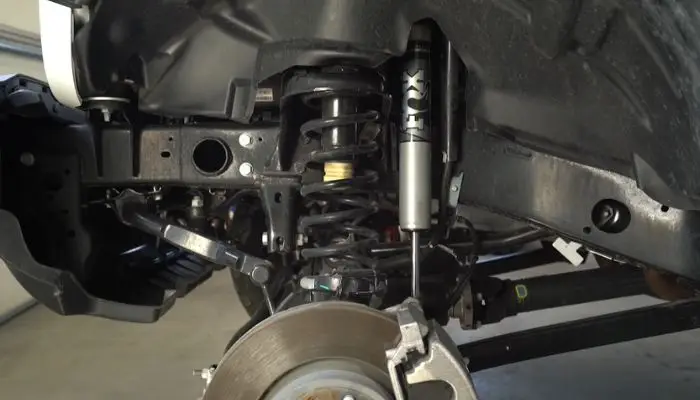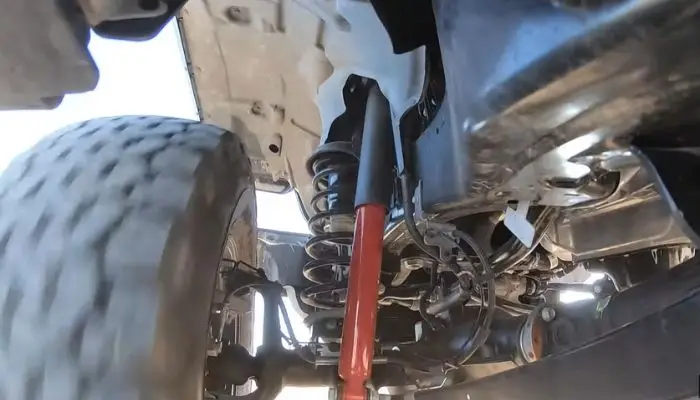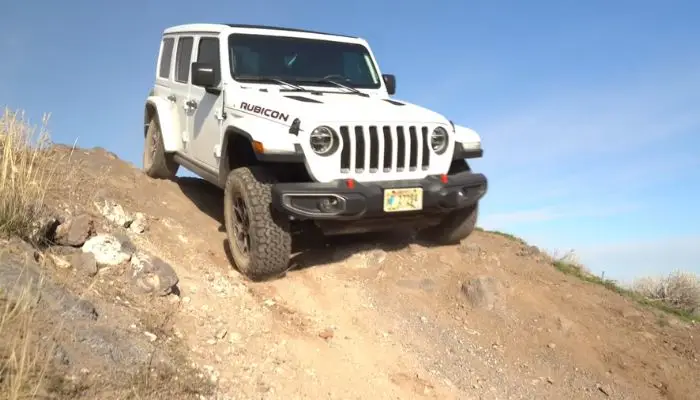Shocks typically last around 50,000 to 100,000 miles on a Jeep Wrangler. Jeep Wranglers are known for their exceptional off-road capabilities and rugged durability.
As with any vehicle, regular maintenance is crucial to keep it running smoothly. One important component that requires attention and occasional replacement is the shocks. Shocks play a vital role in providing a comfortable ride and ensuring the Jeep’s suspension system functions optimally.
The lifespan of shocks on a Jeep Wrangler can vary depending on various factors such as driving conditions, terrain, and maintenance. However, on average, Jeep Wrangler shocks tend to last between 50,000 and 100,000 miles. Understanding the lifespan of shocks can help Jeep owners plan for regular suspension maintenance and replacement to ensure a safe and enjoyable driving experience.

Do Jeep Wranglers Have Shocks Or Struts
If you own a Jeep Wrangler, or are thinking about purchasing one, you may be wondering if they have shocks or struts. The answer is both! Jeep Wranglers come equipped with both shocks and struts, which work together to provide a smooth ride on all types of terrain.
Shocks are designed to absorb impact and reduce the amount of vibration that travels through the frame of the vehicle. They are typically located at the four corners of the vehicle, and can be adjusted to accommodate different driving conditions.
Struts, on the other hand, support the weight of the vehicle and help keep the tires in contact with the ground. They also contribute to the overall stability of the vehicle. Both shocks and struts play an important role in providing a comfortable ride in your Jeep Wrangler.
If you’re ever unsure about which one to adjust for specific driving conditions, consult your owner’s manual or ask a professional mechanic for advice.
How Long Do Shocks And Struts Last
How long do shocks and struts last? This is a question that we often get asked, and it really depends on a few factors.
The first factor is the type of driving that you do. If you do a lot of stop-and-go city driving, your shocks and struts will wear out much faster than if you do mostly highway driving.
The second factor is the quality of the shocks and struts. There are many different brands and levels of quality, so be sure to do your research before purchasing.
Generally speaking, though, most shocks and struts will last between 50,000 and 100,000 miles.
Factors Affecting Shock Lifespan
The lifespan of shocks on a Jeep Wrangler can vary based on several factors. Understanding these influences can help Jeep owners gauge when it might be time to replace their shocks. Driving conditions, quality of shocks, and maintenance all play a role in determining the longevity of Jeep Wrangler shocks.
1. Driving conditions
Driving conditions have a significant impact on the lifespan of shocks. Rough terrains, off-road adventures, and frequent encounters with potholes can accelerate wear and tear on the shocks. Constant exposure to such driving conditions can cause the shocks to deteriorate more quickly, shortening their lifespan.
2. Quality of shocks
The quality of the shocks installed on a Jeep Wrangler also impacts their lifespan. High-quality, durable shocks are designed to withstand the demands of off-road driving, providing an extended lifespan compared to lower-quality alternatives. When opting for replacement shocks, investing in reputable brands known for their durability can contribute to a longer shock lifespan.
3. Terrain
Consistently driving on rough roads or trails will also shorten shock lifespan.
4. Modifications
Lifting your Wrangler or adding heavy accessories can put additional strain on your shocks.
Understanding the factors influencing shock lifespan on a Jeep Wrangler is crucial for maintaining optimal performance and safety. By considering driving conditions, shock quality, and regular maintenance, Jeep owners can effectively manage the lifespan of their vehicle’s shocks.

Signs Of Worn-out Shocks
Jeep Wrangler shocks can last 50,000 miles. Signs of worn-out shocks include excessive bouncing, swaying, or uneven tire wear. Regular inspections and replacements are essential for safe and smooth driving experiences.
Shocks play a crucial role in providing a smooth and comfortable ride in your Jeep Wrangler. Over time, however, these essential components can start to wear down. Recognizing the signs of worn-out shocks is crucial to maintaining your vehicle’s performance and safety. Below, we’ll explore two indicators that your shocks may be past their prime.
Excessive Bouncing
One of the most common signs of worn-out shocks is excessive bouncing while driving. If you notice your Jeep Wrangler bouncing uncontrollably even on relatively smooth surfaces, it’s likely a clear indication that your shocks are no longer effectively dampening the vehicle’s movements.
This bouncing not only compromises your driving experience but also reduces traction and increases the risk of losing control. Don’t ignore this sign; instead, take immediate action to inspect and replace your shocks as necessary.
Uneven Tire Wear
Another telltale sign of worn-out shocks is uneven tire wear. When shocks start to deteriorate, they lose their ability to keep your tires in consistent contact with the road surface. As a result, you may notice uneven patterns of wear on your tires.
If you observe excessive wear on the edges or the middle of the tires, it could be an indication that your shocks need replacement. Ignoring this issue can lead to reduced tire lifespan, compromised handling, and decreased overall vehicle performance.
To summarize, recognizing these signs of worn-out shocks is crucial for maintaining optimal performance and safety in your Jeep Wrangler. Keep an eye out for excessive bouncing and uneven tire wear as indicators that it may be time to replace your shocks.
Don’t delay in addressing these issues, as doing so can help ensure a smoother and safer driving experience for you and your passengers. Remember, regular maintenance and timely replacements are key to keeping your Jeep Wrangler in top shape.
Maintenance Tips To Extend Shock Life
To extend the life of your Jeep Wrangler’s shocks, it is important to perform regular maintenance. This includes checking for leaks, inspecting bushings, and keeping the shocks clean from debris. By following these tips, you can ensure that your shocks last as long as possible.
Regular Inspection
Regularly inspecting your Jeep Wrangler’s shocks is crucial for ensuring their longevity and optimal performance. By taking the time to visually inspect your shocks, you can catch any signs of damage or wear early on, preventing further issues down the road.
During your inspection, pay attention to the condition of the shock housing and mountings, checking for any signs of leakage or rust. Inspect the shock absorber itself, looking for visible signs of damage or wear, such as dents, cracks, or oil stains. Additionally, check the bushings and seals for any signs of deterioration.
Keep an eye out for any unusual noises or vibrations while driving your Jeep. If you notice excessive bouncing, swaying, or a harsh ride quality, it may indicate that your shocks need attention. Addressing these issues promptly can help prolong the lifespan of your shocks and prevent further damage to your vehicle.
Proper Installation
Installing your shocks correctly is essential for their longevity and performance. Improper installation can lead to premature wear and potential safety hazards. Ensure each step of the installation process is followed diligently, referring to your vehicle’s manual or seeking professional assistance if necessary.
Start by preparing your Jeep Wrangler for shock installation. This may involve safely raising and securing the vehicle, removing any necessary components or parts obstructing access to the shocks.
When installing new shocks, ensure they are the correct fit for your Jeep Wrangler model. Double-check that the length, dimensions, and mounting style match the specifications recommended for your vehicle.
Properly tighten all mounting bolts and nuts to the manufacturer’s specifications. Over-tightening or under-tightening can lead to issues like leaks, premature wear, or even detachment of the shocks.
Once the shocks are installed, visually inspect the connections and mountings to ensure everything is properly aligned and secured. Any misalignment or loose connections should be addressed immediately to prevent further damage.
Remember, proper installation of your shocks not only extends their lifespan but also ensures your Jeep Wrangler’s safety and optimal performance on and off the road.
Keep in mind that the lifespan of your shocks can also be influenced by various factors such as driving conditions, terrain, and overall vehicle maintenance. Regularly inspecting and maintaining your shocks will help you identify any issues early on and extend their lifespan, ensuring your Jeep Wrangler remains reliable and capable for years to come.
Replacing Shocks
Replacing shocks on your Jeep Wrangler is an essential part of regular maintenance to ensure a smooth and enjoyable driving experience. Knowing when to replace them and whether to go the DIY route or seek professional help will contribute to maintaining your Jeep’s performance and safety. Here’s what you need to consider when it comes to replacing the shocks on your Jeep Wrangler.
When To Replace
Knowing when to replace the shocks on your Jeep Wrangler is crucial. Shocks typically last around 50,000 miles, but this can vary depending on driving conditions and off-road usage. Look out for signs such as excessive bouncing, uneven tire wear, or a rough ride, which indicate that the shocks may need replacement.
- Excessive bouncing
- Uneven tire wear
- Rough ride
Diy Vs. Professional
Deciding between a DIY replacement and seeking professional help is dependent on your experience and tools available. If you have the knowledge and tools, a DIY approach can save money. However, if you’re uncertain or lack the tools, it’s best to entrust the replacement to a professional to ensure the job is done correctly and safely.
Choosing The Right Shocks
Types Of Shocks
There are three main types of shocks: gas shocks, hydraulic shocks, and foam-cell shocks.
Compatibility With Jeep Wrangler
When selecting shocks for your Jeep Wrangler, ensure compatibility with the model year and suspension type.

Wrapping Up
The lifespan of shocks on a Jeep Wrangler varies depending on usage and conditions. Regular maintenance and inspection are crucial to ensure optimal performance. When it’s time for replacements, consider high-quality shocks to enhance your off-road adventures. Stay informed and proactive to keep your Jeep running smoothly.
FAQs
How many miles do Jeep Wrangler shocks typically last?
Most manufacturers recommend replacing shocks on a Jeep Wrangler between 50,000 and 100,000 miles. However, this is a general guideline, and actual lifespan depends on several factors.
What factors affect how long my Jeep Wrangler shocks will last?
Here’s what can shorten or lengthen shock lifespan:
- Driving style: Aggressive off-roading or frequent heavy loads put more strain on shocks, shortening their life.
- Road conditions: Consistently driving on rough roads accelerates wear and tear.
- Quality of shocks: Premium shocks with robust construction generally last longer.
- Other suspension components: Worn-out springs or other suspension parts negatively impact your shocks.
How do I know if my Jeep Wrangler shocks need replacing?
Look out for these warning signs:
- Excessive bouncing or swaying after bumps
- Nose-diving when braking
- Uneven tire wear
- Fluid leaking around the shocks
- Instability at highway speeds
Can I just replace the worn-out shocks, or should I replace all four?
It’s highly recommended to replace shocks in pairs (both front or both rear) for balanced performance and handling. If all four are near the end of their lifespan, replacing them all at once is more efficient.
Should I replace the shocks on my Jeep Wrangler myself?
Replacing shocks can be a moderately difficult DIY task. If you’re not comfortable with car repairs or lack the right tools, it’s usually better to seek professional help.

